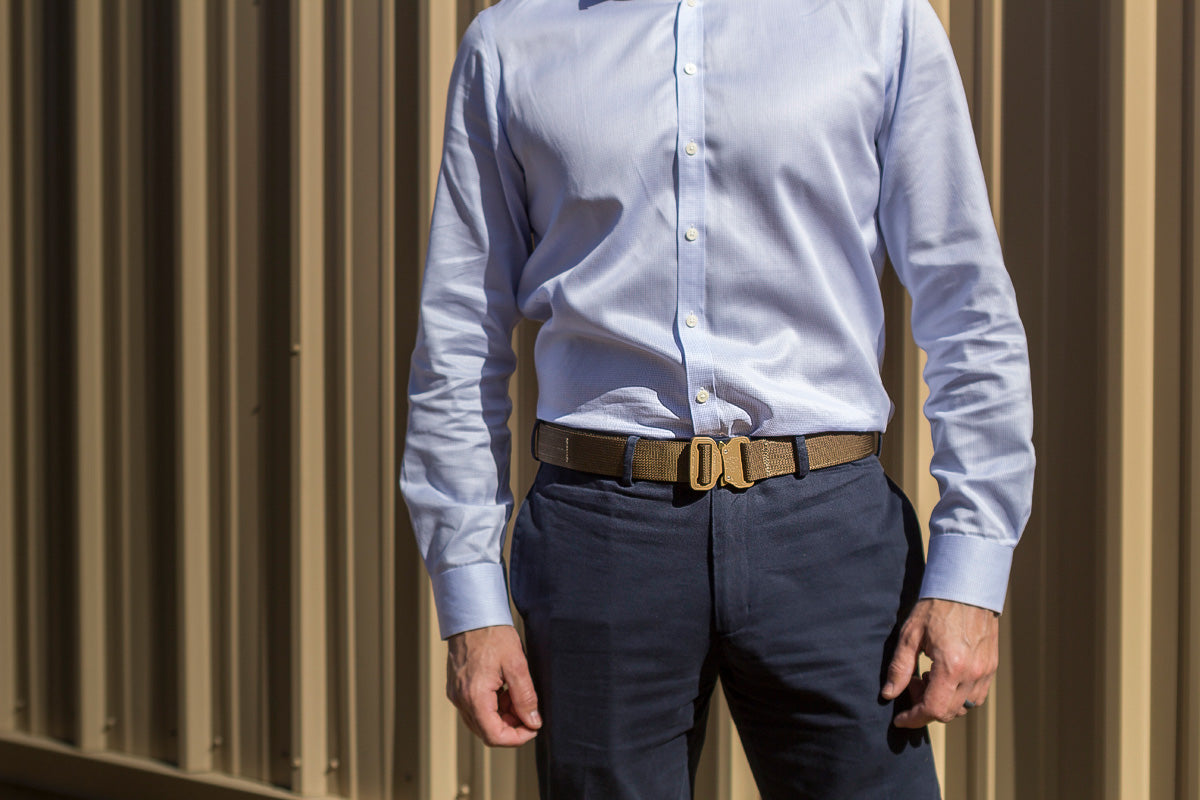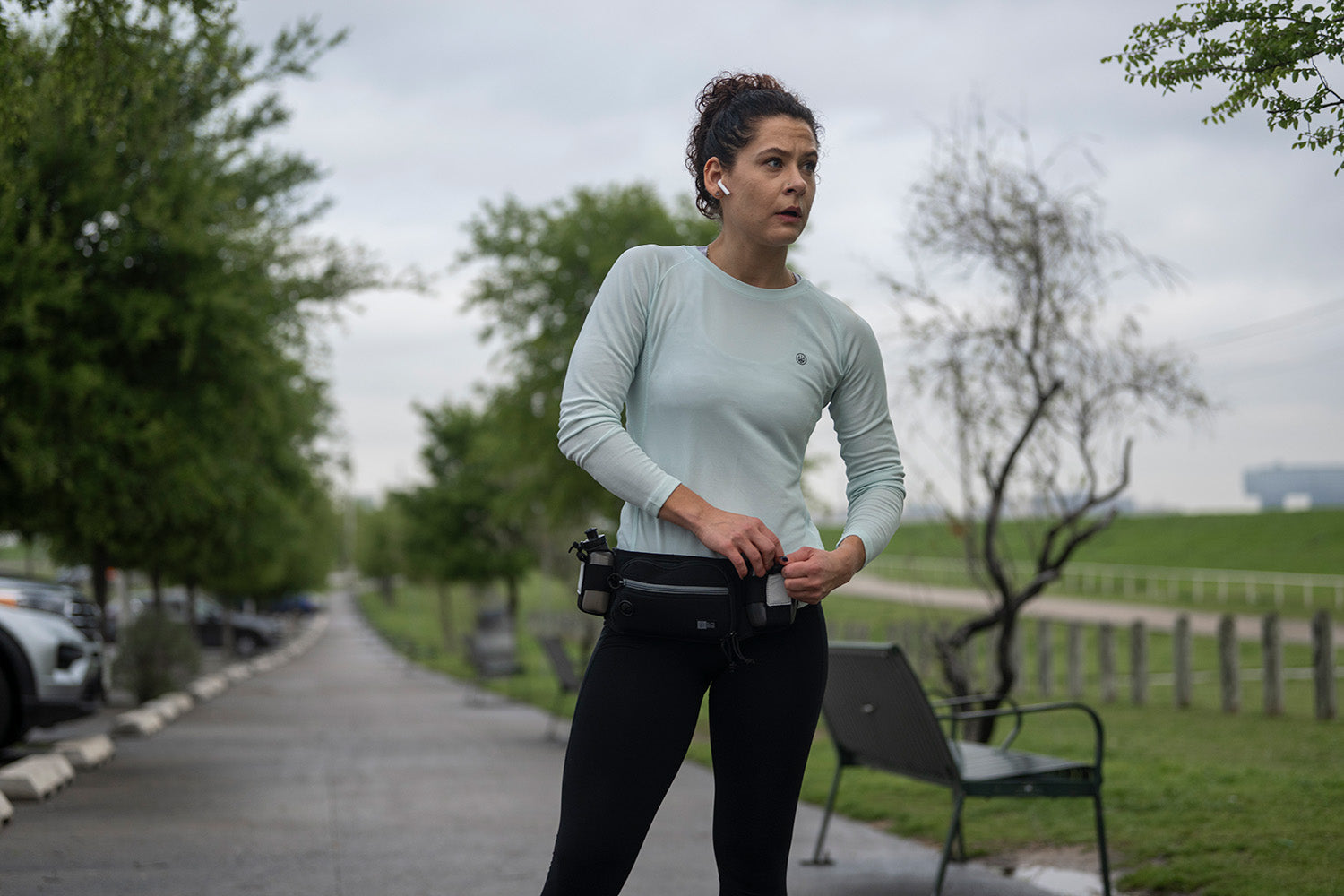Outside the Waistband (OWB)
Outside-the-waistband (OWB) holsters are placed—of course—outside the waistband, which makes them more visible. This position is common for open carry, but you can carry discreetly outside the waistband if you wear the right clothing.
When you carry OWB, you’ll need to wear a layer of loose clothing that conceals the weapon and minimizes printing. A jacket, cardigan, or flannel shirt can cover the holster and firearm. A quality OWB concealed carry holster will also help to keep your gun more low profile.
Inside the Waistband (IWB)
Affixing your holster inside the waistband (IWB) means you place it between your body and the inside of the waistband of your pants. Your clothing will cover most of the gun, and only a small part of the firearm will stick up over the belt line.
IWB and OWB Carry Positions Around the Clock
You can place your holster at different positions along your waistband, with each position referred to as a position on a clock.
For example, the twelve o’clock position is at your navel, and the six o’clock position is at the center of your back. Your right hip is at three o’clock, and your left hip is at nine o’clock. Each position has different pros and cons, so the best position depends on your body type, dominant side, daily activities, and gun type.
If you’re new to carrying a weapon or you’re getting a new waistband carry holster, you’ll need to find a carry position that feels comfortable. The position should also secure your weapon and give you safe and efficient drawing access. The following is a list of clock positions and their ideal purposes or qualities:
- Twelve o’clock: this position is great for carrying long guns.
- One to two o’clock: This position would be ten to eleven o’clock for lefties. It is called appendix carry, or AIWB when inside the waistband. It allows for quick access to the firearm.
- Three o’clock: This position would be nine o’clock for lefties. It is the dominant-side hip carry.
- Four to five o’clock: This position would be seven to eight o’clock for lefties. It is called the kidney carry. This holster position has a forward cant.
- Five to six o’clock: This position would be six to seven o’clock for lefties. It is the small-of-back carry.
- Ten to eleven o’clock: This position would be one to three o’clock for lefties. It is called the cross-draw carry. The butt of the gun is canted forward, and you reach across your body with your strong hand to draw.
When you have a quality holster and choose the right carry position, you can carry comfortably and keep your gun concealed. Signs that you need a different carry position are that your gun protrudes from your clothing, the holster shifts, or the holster holds the gun loosely. If you experience any of these issues, experiment with different clock positions to find one that works for you.
Ankle Carry
With ankle carry, you wear an ankle holster to carry your gun on the inside edge of your non-dominant leg. Pant legs easily hide the firearm, and this position works well for smaller handguns. Or if you carry a secondary firearm, consider wearing it on an ankle holster.
One of the most common ways to draw from an ankle holster from a standing position is to kneel on your dominant-side knee with your holstered leg in front. You’ll then draw the pant leg up with both hands to uncover the holster and gun. Once the pant leg clears the holster, use your dominant hand to grip and draw.
It can feel cumbersome to draw from an ankle holster if you spend most of your time standing. Nevertheless, this is an excellent position for a backup gun.
Shoulder Carry
Some people enjoy using shoulder holsters to carry heavier handguns, as adjustable straps keep the weapon secure. In colder weather, a coat or jacket will keep any firearm in this holster hidden. And since this holster keeps the firearm off the waistband, it gives you an excellent draw position if you’re seated.
Wear a single-side harness if you want to carry one firearm or a double-side harness if you want to carry accessories, such as magazine pouches, flashlight holders, and knife pouches.
However, perhaps the biggest thing to consider about a shoulder holster is the issue of sweeping. When you draw from a shoulder holster, your gun will sweep the area and bystanders before you lock on your target. No matter the holster you choose, you must train to draw, shoot, and holster your weapon with your equipment. But with a shoulder holster, you’ll have to train more and exercise more caution.
Belly Band Holster
If you want to carry at your waist but you lack belt loops, or you feel uncomfortable wearing a typical gun belt and holster, consider a belly band holster. Belly band holsters keep your firearm close to your body and give you a stable and secure carry position.
For example, the Core Defender Belly Band Gun Holster from Elite Survival Systems is made with a 4-inch-wide orthopedic, ergonomic elastic that keeps you cool and dry. It fits small- to large-frame automatics and small- to medium-frame revolvers.
Off-Body Concealed Carry
Finally, another option for carrying a concealed weapon is off your body. Concealed carry bags include fanny packs, backpacks, and messenger bags. Unlike regular bags, manufacturers give concealed carry bags special features that keep your firearm and accessories secure.
Even if you like to carry your weapon directly on you, you might occasionally need a CCW bag. For example, if you go hiking or jogging, a CCW pack around your waist will let you move freely and keep your firearm near your hand for a quick draw.
CCW bags have an understated design that doesn’t make it obvious you’re carrying a weapon. Nevertheless, you should always treat your CCW bag as a holster. Always wear the bag or keep it near you and out of other people’s hands.
As this guide to the different concealed carry holster positions shows, gun owners have practically endless options for where to carry their firearms. Find your next concealed gun holster from Elite Survival Systems. Our goal is to help you carry every day, and we do that by offering a range of holsters suitable for all body types, gun types, and activities. Shop today for waistband holsters, ankle holsters, shoulder holsters, and more.

Also in News

The Elite Survival Systems® Mainstay™ IWB Holster: A Perfect Fit for the Sig Sauer P365

What Belt Should You Wear for Concealed Carry?
Your gun belt's fit, material, and rigidity affect how well you carry your firearm. Read to learn more about finding the concealed carry belt you should wear.

5 Clothing Tips for Those Who Have a Concealed Carry License
If you don’t dress correctly for concealed carry, you risk printing or showing your gun. Use these clothing tips to keep your weapon discreet, yet accessible.

